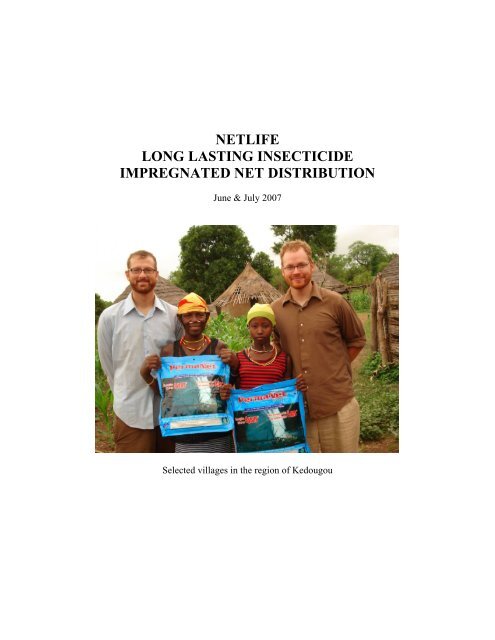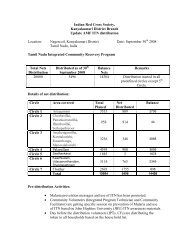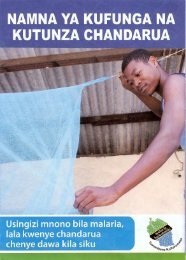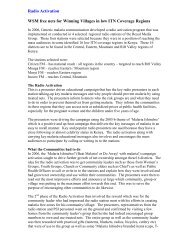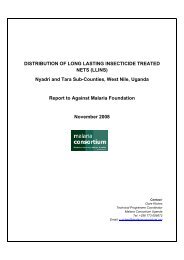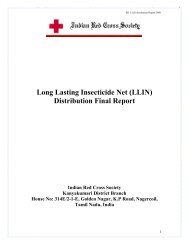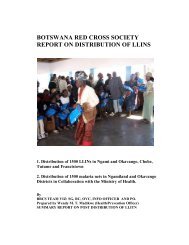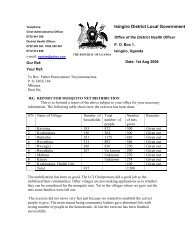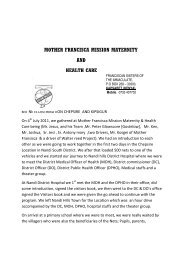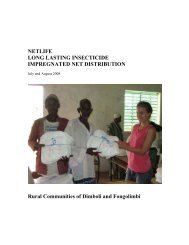netlife long lasting insecticide impregnated net ... - Against Malaria
netlife long lasting insecticide impregnated net ... - Against Malaria
netlife long lasting insecticide impregnated net ... - Against Malaria
Create successful ePaper yourself
Turn your PDF publications into a flip-book with our unique Google optimized e-Paper software.
In Bandafassi, we met with our main counterpart, Mactar Mansaly. Mansaly isthe <strong>long</strong>-time health post nurse in Bandafassi. His post covers 45 outlying rural villages.Together, we looked at his records, took stock of his available medication, and workedwith him as he tested patients with a new Plasmodium Falciparum malaria blood test.Because of this new test, we can finally get accurate data for who really has malaria inthese rural areas.
After talking to Mansaly, we validated the ideas we had about which villages hadthe worst problems. Over the next week and a half, we scouted out villages to determinehow many <strong>net</strong>s villages already had. This was tricky, because generally when we askedpeople about village needs, everyone would always say that nobody had a <strong>net</strong>. This wasnot always the whole truth. In some villages, we would find out one way or another thatmany people already had <strong>net</strong>s. Sometimes, we would find out from people who actuallylived in the village and sometimes Mansaly would let us know that one particular villagewas doing pretty well with <strong>net</strong>s.Some of this information was found our young friend Saliou.Saliou is an 12 year old boy who I’ve known since I was a Peace Corps Volunteerin his village. Saliou tagged a<strong>long</strong> with us on our scouting trips. While we asked villageleaders about everything from crops to the local health care situation, Saliou would hangout at the local well or pump and ask other kids and women about their mosquito <strong>net</strong>situation. Often times, Saliou would get a more accurate picture of who really had <strong>net</strong>sthan we did. For this, he was invaluable.
Outline of the Netlife ProgramOnce we arrived in the village, we had an opportunity to have a very receptive audience.We took advantage of this by teaching some important lessons about malaria and handwashing. This was all done in pulaar and much of it was in a question/answer format (ex:Ko honno jonte noje falorte hara nangani neddo? = What is the best way to protect peoplefrom malaria?)I. Greetings - If we don't greet properly people are instantly turned off. They startthinking we aren't very respectful and start tuning out, so we greet quite thoroughly.II. Who We Are - We introduced ourselves by our names (Ablaye Diallo = Andy andYoussouf Diallo = Jesse) and by our organization. We said Netlife in english andexplained Net equals moustiquaire (french) and sanke (pulaar). Life equals la vie (french)or nduurgam (pulaar). We emphasized the fact that Netlife is a new organization and thatit is not the Peace Corps. We did this so people in these villages didn't start expectingPeace Corps volunteers to start doing mosquito <strong>net</strong> distributions, because right now, theydon't. We really don't want people in the villages driving the Peace Corps volunteerscrazy with requests for <strong>net</strong>s.
Then finally, we distributed the <strong>net</strong>s. We did this by reading off of our prepreparedlists. These lists also included Identity Card numbers. When people wouldcome up for their <strong>net</strong>, they would bring their ID up and we would write down theirnumber. Occasionally, someone would not have an ID Card. With the whole villagetheir, as <strong>long</strong> as everyone validated the fact that the person actually lived in that village,we still gave them a <strong>net</strong>. The ID card set up wasn’t to exclude rural people that had noID, but to instill the idea to the local people that this was an organized and officialdistribution.We also charged 100 cfa per <strong>net</strong>, about $0.20 American. This amount was stillvery minimal, but allowed some sense of ownership of the <strong>net</strong>s to be conveyed. Therewere no people who could not afford this cost. All of this money was donated to anorganization called Senegad, which provides rural adolescent girls arrangements andscholarships to go to higher education facilities.In this village, everyonebrought up their ID cardsbefore we started thedistribution. Here, AndrewSherman is checking the ID’swith a list made of all themarried women.
For one set of five villages, we were even able to provide educational theater.From my past Peace Corps experience, I had trained a group of five villagers to perform askit of a pregnant woman, her husband and the health, social and financial struggles theyencounter with malaria.When these distributions were completed, there was often a celebration ofdancing and singing.
Over the next month and a half, we biked out the mosquito <strong>net</strong>s on footpaths tovillages inaccessible to automobiles. We rode ridiculous distances, and the both of uslost substantial amounts of weight as we performed these exhaustive distributions in 17villages.
RESULTSThe 17 covered villages were reported to our counterpart, so that the Ministry ofHealth could be aware of the coverage. This way when more <strong>net</strong>s arrive, Mansaly wouldknow that these villages were covered. He could then make sure new <strong>net</strong>s go to villageswe couldn’t help on this trip. Mansaly also wrote us this letter of thanks.
The rest of Mactar Mansaly’s letter is a good illustration of our final results.


